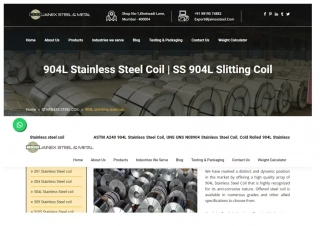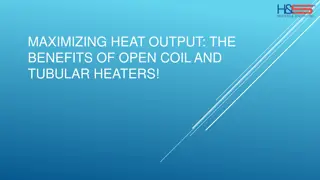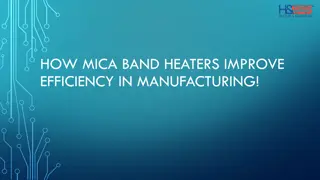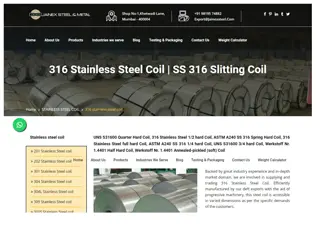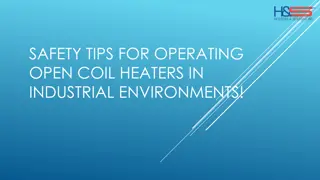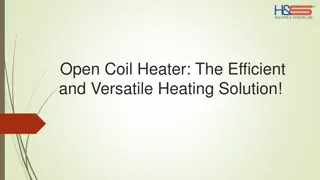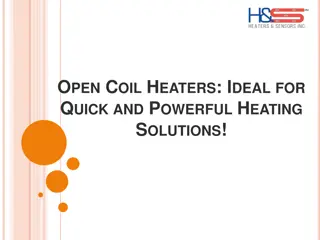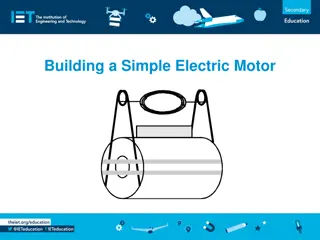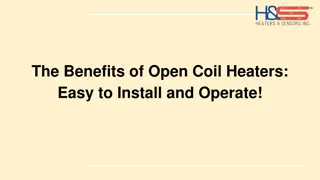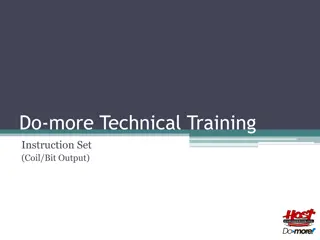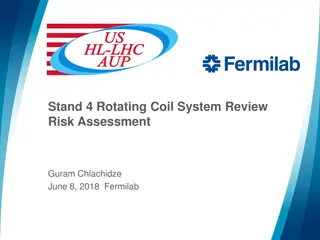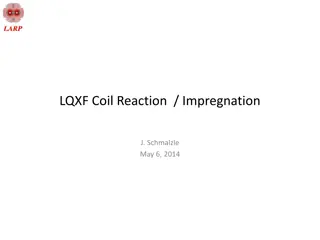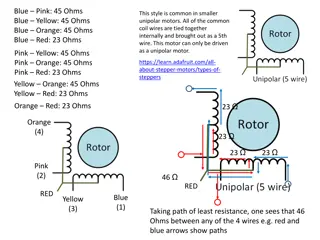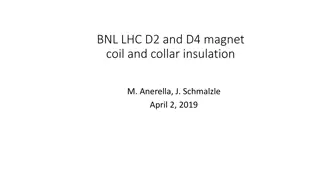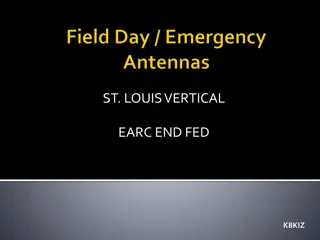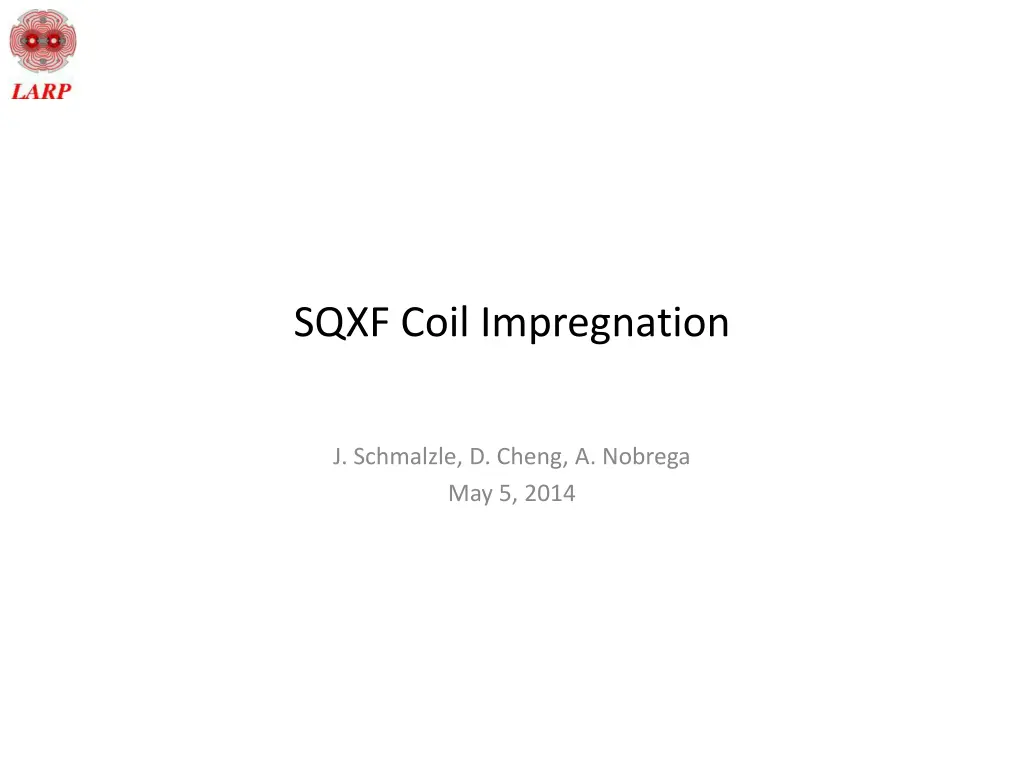
Coil Impregnation Process Overview
Discover the detailed coil impregnation procedure involving materials, equipment setup, and varying processes across different laboratories. Learn about the impregnation methods used at BNL, FNAL, and LBL, along with specific steps, temperature requirements, and vacuum conditions. Explore the intricacies of impregnating coils for optimal performance and durability.
Download Presentation

Please find below an Image/Link to download the presentation.
The content on the website is provided AS IS for your information and personal use only. It may not be sold, licensed, or shared on other websites without obtaining consent from the author. If you encounter any issues during the download, it is possible that the publisher has removed the file from their server.
You are allowed to download the files provided on this website for personal or commercial use, subject to the condition that they are used lawfully. All files are the property of their respective owners.
The content on the website is provided AS IS for your information and personal use only. It may not be sold, licensed, or shared on other websites without obtaining consent from the author.
E N D
Presentation Transcript
SQXF Coil Impregnation J. Schmalzle, D. Cheng, A. Nobrega May 5, 2014
SQXF Impregnation Materials Trace Assembly Perforations marked on trace or pre-cut. Hipot check before install. S2 Fiberglass Cloth Hexcel #4522 with F81 Silane Finish, .13 thick. Laser cut if possible. Mylar G11 Shim, .13 thick. Glass Mylar (with mold release) .25 thick on OD. .13 thick on midplanes. OL Trace G11 Mylar IL Trace Glass JDS - May 5, 2014 2
SQXF Coil Impregnation Procedure Outline: Fixture moved from oven to assembly table. Reaction top plate, form blocks, liner, mica, fiberglass removed. Lead extensions soldered to coil leads. Outer instrumentation trace installed, covered with fiberglass. Short wires soldered to trace. Impregnation liner, form blocks and top plate installed. Fixture bolted closed, flipped over. Reaction mandrel blocks, base plate and mica paper removed. Inner instrumentation trace installed, covered with fiberglass. Impregnation mandrel blocks and base plate installed. Fixture bolted closed. End plates and lead seals installed. Fixture moved to vacuum tank for impregnation. JDS - May 5, 2014 3
SQXF Coil Impregnation Impregnation process varies some between labs due to facility differences: BNL: Impregnation fixture closed and sealed. Strip heaters mounted to outside of fixture used for heating. Fixture hung vertically in vacuum tank. Evacuated to 500 mTorr or below. While under vacuum, bake at 110 C for 8 hours. Cool back to 55 C prior to impregnation. Epoxy mixed and warmed to 55 C. Epoxy degassed to same vacuum level as coil. Once degassed, epoxy pot is let up to atmospheric pressure to start flow. Epoxy introduced into bottom of impregnation fixture (NL end of coil). Fill rate controlled by peristaltic pump, rate of approx. 25 cc / min for about 2 hour fill. Exit line from top of fixture connected to resin trap outside of vacuum tank. When epoxy reaches resin trap the exit line is closed. Supply line remains open, with atmospheric pressure continuing to force resin into coil. Soak overnight at 55 C, while allowing epoxy to continue to draw into coil. Maintain vacuum in tank. JDS - May 5, 2014 4
SQXF Coil Impregnation FNAL: Impregnation fixture connected to open reservoir at LE. Fixture inclined in vacuum furnace. Evacuated to 25 mTorr. While under vacuum, bake at 55 C for 45 hours. Epoxy mixed and warmed to 55 C, degassed. Fill rate observed through glass tube. When epoxy reaches reservoir the supply line is closed. Furnace let up to atmospheric pressure. Soak overnight at 55 C. Fixture then moved to curing oven. JDS - May 5, 2014 5
SQXF Coil Impregnation LBL: Impregnation fixture connected to open reservoir at LE. Strip heaters mounted to aluminum plates on outside of fixture used for heating. Fixture inclined in vacuum tank. Evacuated to approx. 100 mTorr. While under vacuum, bake at 110 C for 6 hours. Cool back to 60 C prior to impregnation. Epoxy mixed and warmed to 55 C. Epoxy degassed to approx. 300 mTorr. Vacuum chamber is increased to approx. 1000 mTorr. Supply line unclamped to start fill. When epoxy reaches reservoir the supply line is closed. Vacuum chamber let up to atmosphere pressure then pumped down again 2X. Chamber let up to atmospheric pressure. Soak overnight at 55 C. JDS - May 5, 2014 6
SQXF Coil Impregnation Cure: Step 1 Ramp from 55C to 110C Step 2 Soak 110C 5 hours Step 3 Ramp from 110C to 125C 1 hour Step 4 Soak 125C 16 hours Final Prep after impreg: Fixture moved to assembly table. Impregnation base plate and mandrel blocks removed. Coil ID cleaned up, holes cleared. Impregnation mandrel blocks and base plate installed. Fixture bolted closed, flipped over. Impregnation top plate, form blocks, liner removed. Coil OD cleaned up, keyway cleared, holes cleared. Instrumentation wire extensions added, connectors installed. Coil transferred to shipping fixture using coil lifting fixture. Coil size measurements taken with CMM. JDS - May 5, 2014 7
SQXF Impregnated Coil Dimensions Nominal Coil Dimensions (Insulated Cable): Inner Radius = 75.000 mm Outer Radius = 113.126 mm Midplane offset = .25 mm Impregnated Coil Dimensions: Includes 10 mil Trace / Kapton / Fiberglass on ID and OD, 5 mil G11 on midplanes: Inner Radius = 74.75 mm Outer Radius = 113.38 mm Midplane offset = .13 mm JDS - May 5, 2014 8
SQXF Coil Impregnation Back up slides JDS - May 5, 2014 9
SQXF Coil Impregnation QA Electrical: QA Mechanical: Before Impreg: Trace Hipot before install - 1000V?? Tap Resistances Heater Resistances Coil RLQ (20, 50, 100, 200, 500, 1000 Hz) Continuity Checks After Impreg Coil Length Coil Azimuthal size After Impreg: Tap Resistances Heater Resistances Hipot checks Levels ??? Coil to Heaters, Coil to Saddles, Heaters to Saddles, Saddle to Saddle Coil RLQ (20, 50, 100, 200, 500, 1000 Hz) Continuity checks After connectors installed: Tap Resistances Heater Resistances Impulse Level ??? Coil RLQ (20, 50, 100, 200, 500, 1000 Hz) JDS - May 5, 2014 10




